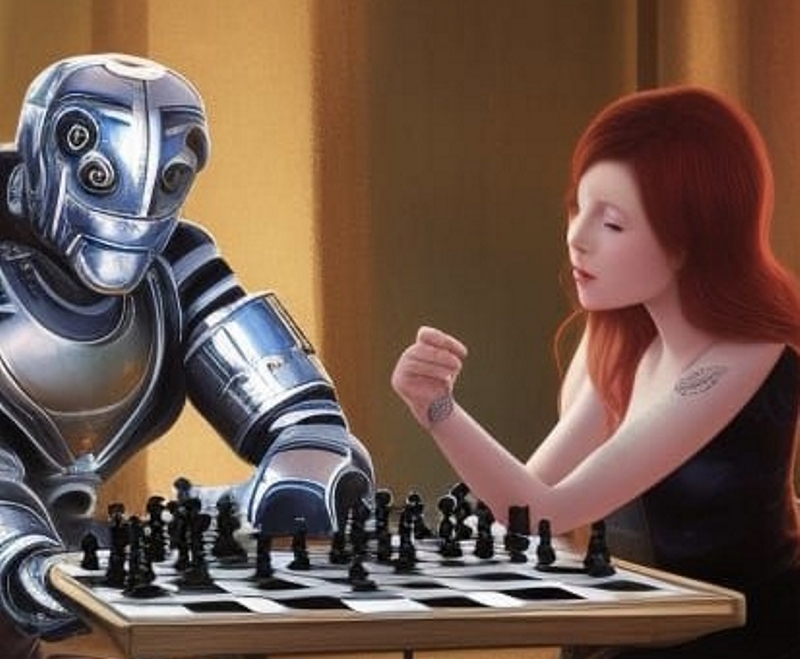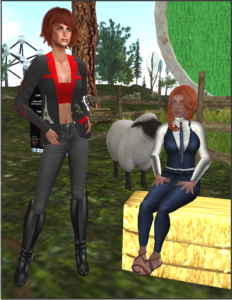
The advent of highly effective, artificial intelligence (AI) engines has many people worried that intelligent machines may take over the world. Artists seem to be especially concerned that a machine may steal their creative livelihoods. Will this be an issue in reality? It is true that AI driven software can write one’s term paper or draw anything one might wish to see.
The picture below was created by software that responded to this request, “Draw a silver robot playing chess with a red-headed woman.“ To create the picture the software used the principles of artificial intelligence and a vast database of images that were hopefully legally acquired. See NightCafe reference below and try your hand at it.

My use of AI is a pleasant diversion but it is seen as a threat to human-created art by many artists and writers. In a recent New York Times essay, David Means had this to say, “I’m not going to go pick a fight with A.I., or even argue with the fact that this technology can mimic artwork, or assist humans in the creation of art, but I can say, right now, here, taking a break from working on my cat story, that A.I. will never be able to do what I can do because A.I. has never felt what I’ve felt. It will never move through the emotional matrix of living a singular, individual life.”
Now Dr. Means is probably right, but works of fiction often can be very convincing to the contrary. For example, the quote below from the film, Blade Runner.
“I’ve seen things you people wouldn’t believe… Attack ships on fire off the shoulder of Orion… I watched C-beams glitter in the dark near the Tannhäuser Gate. All those moments will be lost in time, like tears in rain… Time to die.”
This line, spoken by Rutger Hauer playing the robot Roy Batty, is highly regarded for its keen insight into human feelings. In fact, Wikipedia cites that film “critic Mark Rowlands described it as ‘perhaps the most moving death soliloquy in cinematic history.'”
So, I find it interesting how, we humans as creative beings, create art (films in this case) that both celebrates the potential of intelligent machines and paints an apocalyptic future living with them.
For example. Films that have helpful robots: Short Circuit, WALL-E, and who can forget Robby the Robot in Forbidden Planet. Films that have angry robots: The Matrix or The Terminator.
Some authors have walked along the middle road: They realize intelligent robots are coming and they seek to find ways to keep them from harming humanity. An example is Isaac Asimov’s Three Laws of Robotics. The laws are:
- A robot may not injure a human being or, through inaction, allow a human being to come to harm.
- A robot must obey orders given it by human beings except where such orders would conflict with the First Law.
- A robot must protect its own existence as long as such protection does not conflict with the First or Second Law.
Asimov explores the evolution of robots and how well the laws protect humanity in several series of books. Overall, the robots do find ways to circumvent the rules but robots and humans also find ways to co-exist. One of his novels that I have especially enjoyed is, The Naked Sun.
An interesting middle ground movie is War Games. In this film, a sentient computer is coached to teach itself about the futility of nuclear war so that World War III is avoided. Famous for the line, “How about a nice game of chess?”
I recommend watching/reading these resources for your own insights into the possible futures of humans and machines. If you want to explore interacting with an AI Chat Bot I have rezzed Flicka at my display area on the Science Circle sim in Second Life (See link and photo of Deepy and Flicka below).
 As I write this column, unassisted by AI, my Roomba robot is busy sweeping the carpet.
As I write this column, unassisted by AI, my Roomba robot is busy sweeping the carpet.
References
- Artists decry use of AI-generated art: ‘I’m concerned for the future of human creativity’, Josh Marcus, The Independent, December 10, 2022.
- NightCafe Creator
- NightCafe Review
- A.I. Can’t Write My Cat Story Because It Hasn’t Felt What I Feel, David Means, New York Times, 3-26-23.
- Blade Runner (1982), Wikipedia.
- Tears in rain monologue, Wikipedia.
- The Philosopher at the End of the Universe, Mark Rowlands, 2003, pp. 234–235.
- Short Circuit (1986 film), Wikipedia.
- WALL-E (2008), Wikipedia.
- Forbidden Planet (1956), Wikipedia.
- The Matrix (1999), Wikipedia.
- The Terminator (1984), Wikipedia.
- Isaac Asimov’s “Three Laws of Robotics”, Auburn University.
- Three Laws of Robotics, Wikipedia.
- The Naked Sun (1957), Issac Asimov, Wikipedia.
- War Games (1983), Wikipedia.
- Link to Deepy’s display area on the Science Circle sim in Second Life.
- Animesh AI Bot sold by philomena.fhang in Second Life.
 |
| Visits: 1623300 |
